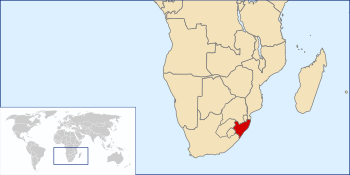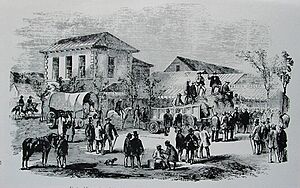Colony of Natal facts for kids
Quick facts for kids
Colony of Natal
|
|||||||||||
|---|---|---|---|---|---|---|---|---|---|---|---|
| 1843–1910 | |||||||||||
|
Anthem: God Save the Queen
|
|||||||||||
 |
|||||||||||
| Status | British colony | ||||||||||
| Capital | Pietermaritzburg | ||||||||||
| Common languages | Afrikaans, English, Zulu | ||||||||||
| Religion | Anglican, Dutch Reformed, Hindu, Presbyterian, Roman Catholic | ||||||||||
| Government | Constitutional monarchy | ||||||||||
| Queen | |||||||||||
| Special Commissioner | |||||||||||
|
• 1843
|
Henry Cloete | ||||||||||
| Historical era | Scramble for Africa | ||||||||||
|
• Established
|
4 May 1843 | ||||||||||
|
• Annexed Zululand
|
1897 | ||||||||||
|
• Disestablished
|
1910 | ||||||||||
|
• Natal Province est.
|
31 May 1910 | ||||||||||
| Area | |||||||||||
| 1904 | 91,610 km2 (35,370 sq mi) | ||||||||||
| Population | |||||||||||
|
• 1904
|
1108754 | ||||||||||
|
|||||||||||
| Today part of | |||||||||||
The Colony of Natal was a British colony in south-eastern Africa. A Crown colony was a territory directly ruled by the British government.
It became a British colony on May 4, 1843. This happened after the British took over the Natalia Republic, which was set up by Dutch settlers called Boers. On May 31, 1910, Natal joined three other colonies to form the Union of South Africa. Today, this area is known as the KwaZulu-Natal province in South Africa.
The colony was originally about half the size of the current province. Its north-eastern border was formed by the Tugela and Buffalo rivers. Beyond these rivers lay the independent Kingdom of Zululand. The province later grew to include Griqualand East in the south.
There was a lot of fighting with the Zulu population. This conflict led to the evacuation of Durban, a major city. Eventually, the Boers accepted British rule in 1844 due to military pressure. The British appointed a governor to the region. Many new settlers came from Europe and the Cape Colony.
The British started a sugar cane industry in the 1860s. It was hard for farm owners to find Zulu workers for their plantations. So, the British brought thousands of workers from India. These workers were called indentured labourers, meaning they worked for a set period to pay off their travel costs. Because of this, Durban became home to the largest group of Indian people outside of India.
Life in the Colony
The colony's population grew quickly between 1849 and 1851. About 4,500 people moved there from the United Kingdom during this time. When these British settlers arrived, trade and farming began to develop. Later, people also started to mine for minerals in the country.
Sugar and Indian Workers
By 1893, when Mahatma Gandhi arrived in Durban, Indian people made up almost half of the non-African population. By 1904, there were more Indian people than white people in Natal. In 1894, Gandhi helped create the Natal Indian Congress. This group worked to fight against unfair treatment of Indian people.
Images for kids
See also
 In Spanish: Colonia de Natal para niños
In Spanish: Colonia de Natal para niños






